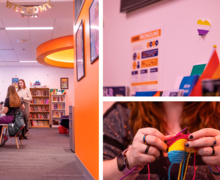Students talk cultural appropriation, representation at ‘My Culture is not Your Costume’
Griffin Uribe Brown | Contributing Writer
The event encouraged audience participation, allowing students to engage with the material and practice the new skills they learned.
To support student journalism and the content you love, become a member of The Daily Orange today.
Freshman Joey Mueller remembers one Halloween as a child when people around him dressed in Indigenous costumes. Though those costumes, and many like them, have been common on Halloween, people have increasingly called them out as cultural appropriation.
Syracuse University’s Office of Student Living hosted “My Culture is not Your Costume” Tuesday, which focused on cultural appropriation during Halloween. Graduate students Emma McAnirlin, Uma Tiwari and Melisa Larranaga hosted the event at Schine Student Center and discussed various types and examples of cultural appropriation as well as how to combat it, especially around Halloween.
“A lot of the time, choices and decisions (to culturally appropriate) are made out of ignorance, not to intentionally be insensitive,” said Dr. Rockell Brown Burton, an associate dean of inclusion, diversity, equity and accessibility at the Newhouse School of Public Communications. “It’s a very healthy and very good thing to have these conversations.”
The hosts explained that Halloween costumes are a form of cultural exploitation, one of the four types of cultural appropriation. The others include cultural exchange, cultural dominance and transculturation.
Tiwari explained a few examples of cultural appropriation on TikTok, including the ‘spa water’ trend, which many people critiqued as an appropriation of the Latin American beverage, agua fresca. The ‘sticky bangs’ trend is an appropriation of the traditionally Black and brown hairstyle of laying edges, she said.
The presenters also outlined the difference between cultural appropriation and appreciation. McAnirlin explained that cultural appreciation occurs when someone invites another person to take part in their culture with celebration and respect. Cultural appropriation, on the other hand, involves stealing and misrepresenting a historically underprivileged group’s culture.
“Spreading awareness is really important, especially on a college campus,” Larranaga said. “There are not a lot of people who think about the four types [of cultural appropriation], they assume there is only one type.”
The presenters and audience members agreed that people should approach conversations about costumes that are meant to represent certain cultures with education in mind, and explain what specifically is hurtful about the costume.
Mueller appreciated the chance to talk openly about cultural appropriation and said this kind of conversation is beneficial for educating others.
“Talks like this help make people aware of what they’re doing wrong,” Mueller said. “By learning this type of content, you can always work to better respect people at all times.”
The event’s hosts also suggested various resources on campus, including the Intercultural Collective (ICC), Office of Multicultural Affairs, Disability Cultural Center, Office of Diversity and Inclusion and Native Student Program to learn more about how to approach Halloween in a respectful manner.
“These conversations are uncomfortable,” Dr. Brown Burton said. “But growth is uncomfortable and in order to reach our fullness, we have to be able to experience discomfort.”

Published on October 26, 2022 at 10:12 pm
Contact Griffin: gbrown19@syr.edu





